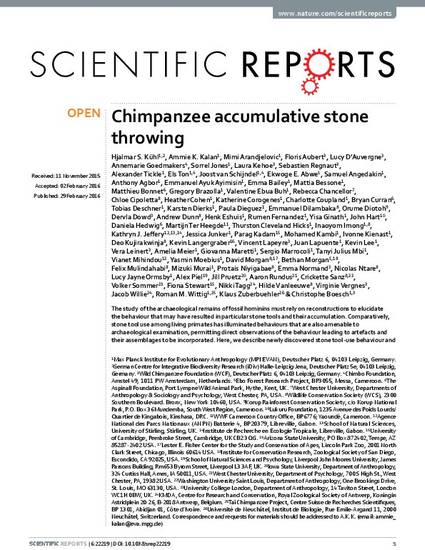
Unpublished Paper
Chimpanzee accumulative stone throwing
Scientific Reports
Document Type
Article
Disciplines
Publication Version
Published Version
Publication Date
1-1-2016
DOI
10.1038/srep22219
Abstract
The study of the archaeological remains of fossil hominins must rely on reconstructions to elucidate the behaviour that may have resulted in particular stone tools and their accumulation. Comparatively, stone tool use among living primates has illuminated behaviours that are also amenable to archaeological examination, permitting direct observations of the behaviour leading to artefacts and their assemblages to be incorporated. Here, we describe newly discovered stone tool-use behaviour and stone accumulation sites in wild chimpanzees reminiscent of human cairns. In addition to data from 17 mid- to long-term chimpanzee research sites, we sampled a further 34 Pan troglodytes communities. We found four populations in West Africa where chimpanzees habitually bang and throw rocks against trees, or toss them into tree cavities, resulting in conspicuous stone accumulations at these sites. This represents the first record of repeated observations of individual chimpanzees exhibiting stone tool use for a purpose other than extractive foraging at what appear to be targeted trees. The ritualized behavioural display and collection of artefacts at particular locations observed in chimpanzee accumulative stone throwing may have implications for the inferences that can be drawn from archaeological stone assemblages and the origins of ritual sites.
Rights
This work is licensed under a Creative Commons Attribution 4.0 International License. The images or other third party material in this article are included in the article’s Creative Commons license, unless indicated otherwise in the credit line; if the material is not included under the Creative Commons license, users will need to obtain permission from the license holder to reproduce the material. To view a copy of this license, visit http://creativecommons.org/licenses/by/4.0
Copyright Owner
The Authors
Copyright Date
2016
Language
en
File Format
application/pdf
Citation Information
Hjalmar S. Kühl, Ammie K. Kalan, Mimi Arandjelovic, Floris Aubert, et al.. "Chimpanzee accumulative stone throwing" Scientific Reports Vol. 6 (2016) p. 22219 Available at: http://works.bepress.com/jill-pruetz/2/

This is an article from Scientific Reports 6 (2016): 22219, doi:10.1038/srep22219. Posted with permission.